Chicago Part 2
Saturday 3rd July
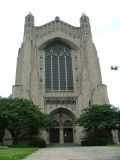
We caught a bus south to the University of Chicago - well, more a bus to where the UC is. We were working from a basic map and after disembarking thought we were lost, but soon realised we were on Midway Plaisance, mentioned in the guidebook as being worth walking along.
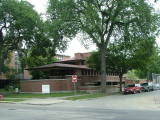
The plan was to see some of UC and get to the Museum of Science & Industry before it started raining. So we wandered along Midway Plaisance, a road with a grassed area, trees and sports grounds in between its East/West lanes. This took us past the Rockefellar Memorial Chapel, which was more like a small cathedral. We then walked past Frank Lloyd Wright's Robie House and took some photos - it could be anyone's house, but the design and style was quite distinctive - the big thin bricks and concrete sections give an elongated impression and make it look not as tall - emphasies the horizontal aspects of it. There were distinctive Frank Lloyd Wright windows - the simple geometric shafts that are at the same time elegant and modern even though the house is nearly 100 years old. It was good to see in real life some of the architecture Rob first learnt about from a friend at Rob's work in Adelaide.
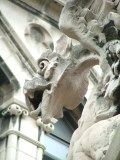
We then continuted along tree lined streets, past houses and University buildings to the main part of the campus, and saw how some Universities are considered to be Ivy League (University of Chicago not amongst them) - the style of the buildings and the Ivy growing over them. We walked through a courtyard and round to the site of the first controlled nuclear reaction - it had been built under some tennis courts on that site. There were many plaques pertaining to the site's place in history and a sculpture. We then walked through some tree lined streets past very nice houses and some obviously shared Uni accomodation and to the Museum of Science and Industry.
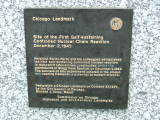
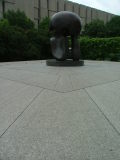
We enjoy Science Museums but were hoping it wasn't going to be another day of basic physics and electricity with hands-on-displays. Well, it lived up to its excellent reputation - we started off in the Coal Mine, a simulated coal mine with equipment, guides in costume, an elevator and train journey, albeit short, and we didn't even have to queue to get to it (the tour book warned of 45 minute lines!). It was very clever - the walls even looked like were were in a mine. The lift door into the mine had a moving wall so that whilst it seemed we had dropped hundreds of metres into the mine we had only dropped a story or two. There were different coal workings set up showing the change in the coal mining technology over its history.
The museum also had a section on farming, including a life sized milking station from a dairy, a tractor and combine harvester to climb on (with cut-away panels to show how it worked and video explaining the workings). There was a large display on Soy and all the common household products (food, plastics, cleaning products) it is used in. There was a simulated section of an aircraft carrier (complete with half an aircraft), submarine (with periscope) and destroyer (control room) and an F-14 flight simulator which we sat in and went for a short take off, engagement and landing with lots of bumps and jolts along the way.
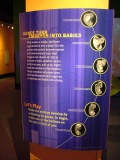
The display on genetics was very good - showing a video on the fertilisation of a human egg and the growth of the embryo, and the importance of genetics. There were also still pictures of fetuses at different stages. There was a chicken hatching surrounded by heaps of people. Every day since 1957 they have put eggs about to hatch in this glass walled incubator and visitors have been able to watch chicks break out of their shells, and start to walk around. Once up and about they are moved into another enclosure adjacent where there were dozens walking around, pecking and feeding.
Along one wall of the genetics exhibition was a row of glass jars with preserved fetuses at different stages of development, from less than one month, through to full term. It was both fascinating to see, and somewhat morbid at the same time. There was a description of each stage of fetal development and a notice stating that all fetuses had died of natural causes. We were quite fascinated because at the time we knew that Jo was about seven weeks pregnant.
In the centre of the museum was an atrium area with a 747 attached to the second floor balcony, and a scale model of Chicago below. The 747 was attached along one side of the fuselage to the balcany and had a wing on the other side suspended over the atrium. At regular intervals throughout the day the aircraft went through a simulated takeoff and landing with the control surfaces and undercarriage moving as if going through the motions. There was also recorded audio of the "flight" giving added realism.
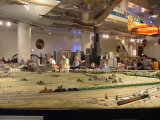
The scale model of Chicago was excellent and it had a model "El" train going around. Alongside the city the model suburbs quickly turned into a huge model train layout with mountains and farmlands, tunnels and bridges. It was pretty cool.
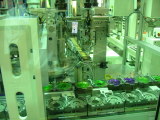
Towards the end of the afternoon we visited the "ToyMaker 3000" section of the Museum. It was an educational exhibit on the steps required to create and sell a new toy from concept and design through manufacturing and marketing. The really fascinating part was a small but real ToyMaker (automated toy factory) making a toy called the "Gravitron". For a small fee, we had a gravitron made with our names on it. So we entered our names and watched as the pieces of the toy were assembled into an automated assembly line - at one point a laser etched our names and the date onto the outside of the gravitron. It was even packaged. It was an excellent exhibit, and was surrounded by many robot exhibits showing what assembly line functions they were capable of, and what they're not. ie the exhibit showed that they were good at precision movement and at repeating defined actions again and again, but were not free thinking or capable of artistic expression.
It was near closing time and so we left (after looking in the shop) and discovered it was raining and there were heaps of people waiting for buses. Many people were crowded in the foyer and under the eaves, as well as packed into the bus shelter. Very soon after walking out the door a bus arrived and it didn't have a route name or number displayed, so we joined a crowd at the door of the bus, eventually getting on board (the usually American Standard Orderly line went out with the rain) and discovering it was the bus we, and most others, wanted. We were packed on the bus like sardines, and in the usual way when in such a situation as that, people were quite friendly. We did notice, however, a free seat near the rear of the bus which someone had their bag on. The bus driver was very helpful expaining over the PA where he was headed (it was an express bus back to the city, and then particular stops) and repeated it a number of times. We passed along roads being blocked off for the fire-works later that night, and the driver informed us of where buses would be running that night and where to catch them. We were soon back at the hotel keeping an eye out the window on the weather.
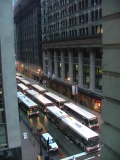
As night approached buses started accumulating in the street outside our hotel. We listened to part of a concert which was broadcast live from Grant Park. By the time we were ready to leave, the rain had passed, and many of the lanes outside our hotel were full of buses ready to collect the crowds after the fireworks. We walked straight east towards the river. With each block the stream of pedestrians increased until we reached Grant Park. We kept walking towards the lake to find a spot to watch the fireworks - as in these cases of a new city and a public event the problem becomes where to view it from and especially with fireworks, where they will be. On the way we passed a worman who was offering a plate of cupcakes with little American flags stuck in them. We accepted her gift with thanks, and then wondered if there might be something wrong with them - a thought that seemed to have occured to others by their reluctance to accept them. But, one cannot live constantly doubting the generosity of others, so we did eat them.
We passed many police, and then came to another North/South street which had been blocked off so that pedestrians could roam (and as we saw later, emergency vehicles had quick access) and we stopped on the lake side of the street and decided we had a good view in the direction everyone seemed to be looking.
We had Jo's little Sony radio with us and we tuned into the station broadcasting the music for the fireworks. We knew it was about to start when Jo recognised the 1812 Oveture playing - soon enough cannon like blasts occurred with the music (no fireworks). After it finished the specially coreographed (and prerecorded) music started on the radio with the fireworks. Whereas with other fireworks we have seen where the "bangs" were synced with the music, no matter where they were observed from, it was the sight of the exploding fireworks that was in sync with the music. The fireworks were excellent - with a whole range of music, many patriotic songs, quite a few we'd not heard before. The fireworks appeared large in the sky in front of us over the water. It was the best fireworks shows we'd seen in years - the music really added - and it was quite long, over 20 minutes. Once over, we turned around and retraced our steps back to the hotel. We passed a line of mounted police and were quickly engulfed in the huge crowd moving in the same direction. Just thousands and thousands of people. When we arrived back at the hotel there were still many buses waiting but they were starting to disperse.
Sunday 4th July
The forecast was for rain. The streets were wet, but when we ventured out it was fine. We walked down the Art Instutite, a grand stone building on the border of Grant Park. We had planned to spend the morning looking around and had a list of sites we wanted to see - the Fodor's guide Jo had borrowed from the library had a list of "must sees", and we started with the Impressions Paintings, where we saw Picasso and then the contemporary art.
There were some well known artists displayed - from Monet to Pollock. We took a brief walk through the Arms and Armory, but quickly decided we'd seen better at the
Met. The stained glass windows "America Windows" representing music, art, literature, liberty, theatre, and dance by Marc Chagall were just beautiful - the blues were just irradescenct. There was a lecture being held late morning and so we joined the group and trapsed up to Jackson Pollock's
Greyed Rainbow where the lecturer told us about Pollock, his life, his art, and compared it to some of his peers. Rob had not realised that Pollock, like so many artists, only became famous after his death, and that he hadn't seen a penny of the money paid by the Australian Government for
Blue Poles.

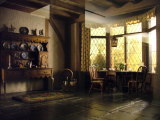
After the lecture we headed to the lowest floor and a display of the Thorne Minature Rooms. This was one of the highlights of the Art Institute. Scale model rooms, depicting the style of specific periods, mounted in the walls. Looking into them was like being a giant peeking into someone's house. Furniture, wall hanging, sculpture, crockery, cooking utensils, table cloths, gardens, candles, paintings, wall paper, all just like the real thing, except scaled down. There were dozens of these rooms. The rooms often had open doors/windows which peered out into gardens, or into other rooms in the house. Each display was separate, not joining up to make part of a larger house. We stood mesmerised by the intricate details of each. The were designed by Mrs James Ward Thorne who had craftsmen make the furniture, etc, to her exacting specifications. The rooms were all donated to the Art Institute and have been a popular attraction since.
One last thing we made a point to see was the glass paperweight collection. Some of the paper weights had glass objects (eg flowers, fruits) in them, whilst many others were of the array of flowers - a glass blob with dozens of tiny flowers arrayed inside. This style of paperweight was developed in France (
Book). We had seen one or two like this before, but not such a huge range and variation. It was fascinating to see.
After the Art Institute we walked to the Taste and bought some tastes -
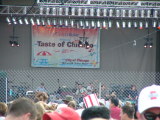
buffalo burger (buffalo meat pattie in a bread roll), Spinach and Cheese Stuffed Crust Pizza (pizza with cheese and spinach between two layers of dough and topped with a tomato sauce, or marinara sauce as the Americans call it), three cheese ravioli and hot dog (disappointing), and went and found ourselves a spot on the grass amongst the people at the free concert. We could have gone inside the fenced area, but there was an enormous queue and they didn't allow "bottles" whether that meant plastic or glass, we didn't know. The concert featured Old 97s,
They Might Be Giants (TMBG) - Jo's favourite band, and Counting Crows (who Rob had heard of, but Jo hadn't, and when we returned home the
TiVo had a video clip of Counting Crows in Shrek 2). Our view was obstructed by the fence and by people on the path in front of us. We did enjoy hearing TMBG live, and whilst it was difficult at times to clearly hear what was being said, any closer and we'd have needed the ear plugs that Jo had brought.
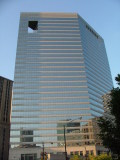
There were dark clouds overhead at times but the forecast of storms didn't eventuate, and when the clouds moved on we sweltered under the hot sun and high humidity. We decided to leave the concert after TMBG and went to Navy Pier. There we joined the multitudes trying to find a good spot to watch the fireworks, and to find a view of the city with the setting sun in the background. We didn't really succeed at either - we got some nice views of the city, though a bit obstructed, and did get to walk through the Museum of Stained Glass windows, which was quite beautiful, but we then spent a fruitless half hour in a line at McDonalds, only to have people push in as time for the fireworks approached, and so we went and found somewhere to watch the fireworks and ate a packet of crisps/chips.
The fireworks didn't start until 40 minutes after their advertised start (well, every pamphlet had a different time, and the PA announcement, whilst agreeing with one pamphlet, was also wrong) and then there was a tree in our view. All in all, not as good as the previous night. After we walked a mile or two back to the hotel, which was a bit of an adventure - for the first mile we were part of a continuous stream of people leaving Navy Pier and disipating into carparks, train stations and apartments. Once over the river, we discovered we were on the second level of road - ie under the city streets. We thought if we kept walking we'd find some stairs, but soon came across a "No Pedestrians" sign and so had to walk into a carpark and take an elevator to street level - which turned out to be inside a highrise building and so we had to ask for directions out to the street. From there, the streets were progressively less populated but still a surprising number of people were out walking at 11 pm on Sunday night.
Monday 5th July
We had read reviews of the hotel on the web before purchasing the vacation package and one criticism was that the hotel wouldn't store baggage after checkout. Well, the reviewer seemed to have been in a different hotel - they had a room in the lobby just for baggage and special tags for each bag! This certainly made our day easier as we then caught the El (elevated) train around the city and another train underground North to the John Hancock building.
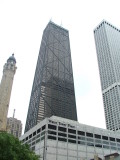
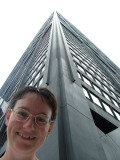
The John Hancock building is the second tallest in Chicago (Sears Tower being the tallest) and the tallest multiuse building in the world (?) - there are apartments from floors 48 to 90? and office and parking below that. The observatory was on the 93rd floor and the superfast lift took 40 seconds from the ground to the 93rd floor. The John Hancock building was designed in the industrial style - with a plain steel and glass exterior, and no ornamentation. One variation on the industrial style is the placement of the cross bracing on the exterior of the building - this cross bracing provides strength in the wind, which can move the top of the building five inches in strong wind. Usually the cross bracing is internal on the elevator shaft (central core) and so is unseen. There were very few people in the observatory when we arrived and so we had unobstructed views.
We listened to an audio tour, which had numbered stops around the building. Upon entering the number into the audio device, we listened to stories, had sights "pointed out", and learnt about the history of the city and its buildings. The world looks different from 1000 feet up in the air. We could see rooftop swimming pools on highrise apartments, see the regular layout of the streets, and could see for miles in all directions - though the overcast weather did stop us from seeing the other side of Lake Michigan, and Wisconsin to the North. There were great views of the beaches on the lake shore, of the city and its buildings, of multilevel freeways, the Navy Pier, and in the distance Lincoln Park (zoo, conservatory) in the North, and Soldier Field to the south.
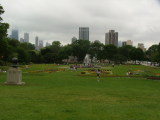
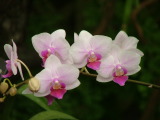
After visiting the John Hancock building we walked south to the historic water tower and pumping station, where there was a visitor's centre. We caught the free shuttle to Lincoln Park - the driver of which kept up a nonstop banter about everything, including musical interludes courtesy of his mobile phone. He even used the external speaker on the bus (well it was built to look like a tram) to make jokes about passers by - at one point we were stopped at a traffic light and he asked a bystander if he knew the way to somewhere (heaven, home, can't remember). Not everyone on the bus enjoyed it, but it made the trip pass quickly. We only had an hour to spend in Lincoln Park and enjoyed walking around the conservatory admiring the many plants, including a Tasmanian Wattle. It wasn't too crowded, even though it seemed like half of Chicago was visiting Lincoln Park (the roads, restrooms and buses were packed). The view of the city skyline was great and we saw the tops of the Hancock building and Sears tower poking into the low cloud - it seemed we had picked a good time to visit.
We caught another free shuttle back to our hotel, ate McDonalds across the street from the Sears Tower and then caught the train to the airport. Once again whilst on the train to the airport we passed through suburbs which were full of classic American street scenes - the country style houses, the brownstones, the leafy green streets, and the scenes that looked like Sesame Street (without the bright furry characters).


 We caught a bus south to the University of Chicago - well, more a bus to where the UC is. We were working from a basic map and after disembarking thought we were lost, but soon realised we were on Midway Plaisance, mentioned in the guidebook as being worth walking along.
We caught a bus south to the University of Chicago - well, more a bus to where the UC is. We were working from a basic map and after disembarking thought we were lost, but soon realised we were on Midway Plaisance, mentioned in the guidebook as being worth walking along.  The plan was to see some of UC and get to the Museum of Science & Industry before it started raining. So we wandered along Midway Plaisance, a road with a grassed area, trees and sports grounds in between its East/West lanes. This took us past the Rockefellar Memorial Chapel, which was more like a small cathedral. We then walked past Frank Lloyd Wright's Robie House and took some photos - it could be anyone's house, but the design and style was quite distinctive - the big thin bricks and concrete sections give an elongated impression and make it look not as tall - emphasies the horizontal aspects of it. There were distinctive Frank Lloyd Wright windows - the simple geometric shafts that are at the same time elegant and modern even though the house is nearly 100 years old. It was good to see in real life some of the architecture Rob first learnt about from a friend at Rob's work in Adelaide.
The plan was to see some of UC and get to the Museum of Science & Industry before it started raining. So we wandered along Midway Plaisance, a road with a grassed area, trees and sports grounds in between its East/West lanes. This took us past the Rockefellar Memorial Chapel, which was more like a small cathedral. We then walked past Frank Lloyd Wright's Robie House and took some photos - it could be anyone's house, but the design and style was quite distinctive - the big thin bricks and concrete sections give an elongated impression and make it look not as tall - emphasies the horizontal aspects of it. There were distinctive Frank Lloyd Wright windows - the simple geometric shafts that are at the same time elegant and modern even though the house is nearly 100 years old. It was good to see in real life some of the architecture Rob first learnt about from a friend at Rob's work in Adelaide. We then continuted along tree lined streets, past houses and University buildings to the main part of the campus, and saw how some Universities are considered to be Ivy League (University of Chicago not amongst them) - the style of the buildings and the Ivy growing over them. We walked through a courtyard and round to the site of the first controlled nuclear reaction - it had been built under some tennis courts on that site. There were many plaques pertaining to the site's place in history and a sculpture. We then walked through some tree lined streets past very nice houses and some obviously shared Uni accomodation and to the Museum of Science and Industry.
We then continuted along tree lined streets, past houses and University buildings to the main part of the campus, and saw how some Universities are considered to be Ivy League (University of Chicago not amongst them) - the style of the buildings and the Ivy growing over them. We walked through a courtyard and round to the site of the first controlled nuclear reaction - it had been built under some tennis courts on that site. There were many plaques pertaining to the site's place in history and a sculpture. We then walked through some tree lined streets past very nice houses and some obviously shared Uni accomodation and to the Museum of Science and Industry. The display on genetics was very good - showing a video on the fertilisation of a human egg and the growth of the embryo, and the importance of genetics. There were also still pictures of fetuses at different stages. There was a chicken hatching surrounded by heaps of people. Every day since 1957 they have put eggs about to hatch in this glass walled incubator and visitors have been able to watch chicks break out of their shells, and start to walk around. Once up and about they are moved into another enclosure adjacent where there were dozens walking around, pecking and feeding.
The display on genetics was very good - showing a video on the fertilisation of a human egg and the growth of the embryo, and the importance of genetics. There were also still pictures of fetuses at different stages. There was a chicken hatching surrounded by heaps of people. Every day since 1957 they have put eggs about to hatch in this glass walled incubator and visitors have been able to watch chicks break out of their shells, and start to walk around. Once up and about they are moved into another enclosure adjacent where there were dozens walking around, pecking and feeding. The scale model of Chicago was excellent and it had a model "El" train going around. Alongside the city the model suburbs quickly turned into a huge model train layout with mountains and farmlands, tunnels and bridges. It was pretty cool.
The scale model of Chicago was excellent and it had a model "El" train going around. Alongside the city the model suburbs quickly turned into a huge model train layout with mountains and farmlands, tunnels and bridges. It was pretty cool. Towards the end of the afternoon we visited the "ToyMaker 3000" section of the Museum. It was an educational exhibit on the steps required to create and sell a new toy from concept and design through manufacturing and marketing. The really fascinating part was a small but real ToyMaker (automated toy factory) making a toy called the "Gravitron". For a small fee, we had a gravitron made with our names on it. So we entered our names and watched as the pieces of the toy were assembled into an automated assembly line - at one point a laser etched our names and the date onto the outside of the gravitron. It was even packaged. It was an excellent exhibit, and was surrounded by many robot exhibits showing what assembly line functions they were capable of, and what they're not. ie the exhibit showed that they were good at precision movement and at repeating defined actions again and again, but were not free thinking or capable of artistic expression.
Towards the end of the afternoon we visited the "ToyMaker 3000" section of the Museum. It was an educational exhibit on the steps required to create and sell a new toy from concept and design through manufacturing and marketing. The really fascinating part was a small but real ToyMaker (automated toy factory) making a toy called the "Gravitron". For a small fee, we had a gravitron made with our names on it. So we entered our names and watched as the pieces of the toy were assembled into an automated assembly line - at one point a laser etched our names and the date onto the outside of the gravitron. It was even packaged. It was an excellent exhibit, and was surrounded by many robot exhibits showing what assembly line functions they were capable of, and what they're not. ie the exhibit showed that they were good at precision movement and at repeating defined actions again and again, but were not free thinking or capable of artistic expression. As night approached buses started accumulating in the street outside our hotel. We listened to part of a concert which was broadcast live from Grant Park. By the time we were ready to leave, the rain had passed, and many of the lanes outside our hotel were full of buses ready to collect the crowds after the fireworks. We walked straight east towards the river. With each block the stream of pedestrians increased until we reached Grant Park. We kept walking towards the lake to find a spot to watch the fireworks - as in these cases of a new city and a public event the problem becomes where to view it from and especially with fireworks, where they will be. On the way we passed a worman who was offering a plate of cupcakes with little American flags stuck in them. We accepted her gift with thanks, and then wondered if there might be something wrong with them - a thought that seemed to have occured to others by their reluctance to accept them. But, one cannot live constantly doubting the generosity of others, so we did eat them.
As night approached buses started accumulating in the street outside our hotel. We listened to part of a concert which was broadcast live from Grant Park. By the time we were ready to leave, the rain had passed, and many of the lanes outside our hotel were full of buses ready to collect the crowds after the fireworks. We walked straight east towards the river. With each block the stream of pedestrians increased until we reached Grant Park. We kept walking towards the lake to find a spot to watch the fireworks - as in these cases of a new city and a public event the problem becomes where to view it from and especially with fireworks, where they will be. On the way we passed a worman who was offering a plate of cupcakes with little American flags stuck in them. We accepted her gift with thanks, and then wondered if there might be something wrong with them - a thought that seemed to have occured to others by their reluctance to accept them. But, one cannot live constantly doubting the generosity of others, so we did eat them. After the lecture we headed to the lowest floor and a display of the Thorne Minature Rooms. This was one of the highlights of the Art Institute. Scale model rooms, depicting the style of specific periods, mounted in the walls. Looking into them was like being a giant peeking into someone's house. Furniture, wall hanging, sculpture, crockery, cooking utensils, table cloths, gardens, candles, paintings, wall paper, all just like the real thing, except scaled down. There were dozens of these rooms. The rooms often had open doors/windows which peered out into gardens, or into other rooms in the house. Each display was separate, not joining up to make part of a larger house. We stood mesmerised by the intricate details of each. The were designed by Mrs James Ward Thorne who had craftsmen make the furniture, etc, to her exacting specifications. The rooms were all donated to the Art Institute and have been a popular attraction since.
After the lecture we headed to the lowest floor and a display of the Thorne Minature Rooms. This was one of the highlights of the Art Institute. Scale model rooms, depicting the style of specific periods, mounted in the walls. Looking into them was like being a giant peeking into someone's house. Furniture, wall hanging, sculpture, crockery, cooking utensils, table cloths, gardens, candles, paintings, wall paper, all just like the real thing, except scaled down. There were dozens of these rooms. The rooms often had open doors/windows which peered out into gardens, or into other rooms in the house. Each display was separate, not joining up to make part of a larger house. We stood mesmerised by the intricate details of each. The were designed by Mrs James Ward Thorne who had craftsmen make the furniture, etc, to her exacting specifications. The rooms were all donated to the Art Institute and have been a popular attraction since. buffalo burger (buffalo meat pattie in a bread roll), Spinach and Cheese Stuffed Crust Pizza (pizza with cheese and spinach between two layers of dough and topped with a tomato sauce, or marinara sauce as the Americans call it), three cheese ravioli and hot dog (disappointing), and went and found ourselves a spot on the grass amongst the people at the free concert. We could have gone inside the fenced area, but there was an enormous queue and they didn't allow "bottles" whether that meant plastic or glass, we didn't know. The concert featured Old 97s, They Might Be Giants (TMBG) - Jo's favourite band, and Counting Crows (who Rob had heard of, but Jo hadn't, and when we returned home the TiVo had a video clip of Counting Crows in Shrek 2). Our view was obstructed by the fence and by people on the path in front of us. We did enjoy hearing TMBG live, and whilst it was difficult at times to clearly hear what was being said, any closer and we'd have needed the ear plugs that Jo had brought.
buffalo burger (buffalo meat pattie in a bread roll), Spinach and Cheese Stuffed Crust Pizza (pizza with cheese and spinach between two layers of dough and topped with a tomato sauce, or marinara sauce as the Americans call it), three cheese ravioli and hot dog (disappointing), and went and found ourselves a spot on the grass amongst the people at the free concert. We could have gone inside the fenced area, but there was an enormous queue and they didn't allow "bottles" whether that meant plastic or glass, we didn't know. The concert featured Old 97s, They Might Be Giants (TMBG) - Jo's favourite band, and Counting Crows (who Rob had heard of, but Jo hadn't, and when we returned home the TiVo had a video clip of Counting Crows in Shrek 2). Our view was obstructed by the fence and by people on the path in front of us. We did enjoy hearing TMBG live, and whilst it was difficult at times to clearly hear what was being said, any closer and we'd have needed the ear plugs that Jo had brought. There were dark clouds overhead at times but the forecast of storms didn't eventuate, and when the clouds moved on we sweltered under the hot sun and high humidity. We decided to leave the concert after TMBG and went to Navy Pier. There we joined the multitudes trying to find a good spot to watch the fireworks, and to find a view of the city with the setting sun in the background. We didn't really succeed at either - we got some nice views of the city, though a bit obstructed, and did get to walk through the Museum of Stained Glass windows, which was quite beautiful, but we then spent a fruitless half hour in a line at McDonalds, only to have people push in as time for the fireworks approached, and so we went and found somewhere to watch the fireworks and ate a packet of crisps/chips.
There were dark clouds overhead at times but the forecast of storms didn't eventuate, and when the clouds moved on we sweltered under the hot sun and high humidity. We decided to leave the concert after TMBG and went to Navy Pier. There we joined the multitudes trying to find a good spot to watch the fireworks, and to find a view of the city with the setting sun in the background. We didn't really succeed at either - we got some nice views of the city, though a bit obstructed, and did get to walk through the Museum of Stained Glass windows, which was quite beautiful, but we then spent a fruitless half hour in a line at McDonalds, only to have people push in as time for the fireworks approached, and so we went and found somewhere to watch the fireworks and ate a packet of crisps/chips.
 The John Hancock building is the second tallest in Chicago (Sears Tower being the tallest) and the tallest multiuse building in the world (?) - there are apartments from floors 48 to 90? and office and parking below that. The observatory was on the 93rd floor and the superfast lift took 40 seconds from the ground to the 93rd floor. The John Hancock building was designed in the industrial style - with a plain steel and glass exterior, and no ornamentation. One variation on the industrial style is the placement of the cross bracing on the exterior of the building - this cross bracing provides strength in the wind, which can move the top of the building five inches in strong wind. Usually the cross bracing is internal on the elevator shaft (central core) and so is unseen. There were very few people in the observatory when we arrived and so we had unobstructed views.
The John Hancock building is the second tallest in Chicago (Sears Tower being the tallest) and the tallest multiuse building in the world (?) - there are apartments from floors 48 to 90? and office and parking below that. The observatory was on the 93rd floor and the superfast lift took 40 seconds from the ground to the 93rd floor. The John Hancock building was designed in the industrial style - with a plain steel and glass exterior, and no ornamentation. One variation on the industrial style is the placement of the cross bracing on the exterior of the building - this cross bracing provides strength in the wind, which can move the top of the building five inches in strong wind. Usually the cross bracing is internal on the elevator shaft (central core) and so is unseen. There were very few people in the observatory when we arrived and so we had unobstructed views.
 After visiting the John Hancock building we walked south to the historic water tower and pumping station, where there was a visitor's centre. We caught the free shuttle to Lincoln Park - the driver of which kept up a nonstop banter about everything, including musical interludes courtesy of his mobile phone. He even used the external speaker on the bus (well it was built to look like a tram) to make jokes about passers by - at one point we were stopped at a traffic light and he asked a bystander if he knew the way to somewhere (heaven, home, can't remember). Not everyone on the bus enjoyed it, but it made the trip pass quickly. We only had an hour to spend in Lincoln Park and enjoyed walking around the conservatory admiring the many plants, including a Tasmanian Wattle. It wasn't too crowded, even though it seemed like half of Chicago was visiting Lincoln Park (the roads, restrooms and buses were packed). The view of the city skyline was great and we saw the tops of the Hancock building and Sears tower poking into the low cloud - it seemed we had picked a good time to visit.
After visiting the John Hancock building we walked south to the historic water tower and pumping station, where there was a visitor's centre. We caught the free shuttle to Lincoln Park - the driver of which kept up a nonstop banter about everything, including musical interludes courtesy of his mobile phone. He even used the external speaker on the bus (well it was built to look like a tram) to make jokes about passers by - at one point we were stopped at a traffic light and he asked a bystander if he knew the way to somewhere (heaven, home, can't remember). Not everyone on the bus enjoyed it, but it made the trip pass quickly. We only had an hour to spend in Lincoln Park and enjoyed walking around the conservatory admiring the many plants, including a Tasmanian Wattle. It wasn't too crowded, even though it seemed like half of Chicago was visiting Lincoln Park (the roads, restrooms and buses were packed). The view of the city skyline was great and we saw the tops of the Hancock building and Sears tower poking into the low cloud - it seemed we had picked a good time to visit.